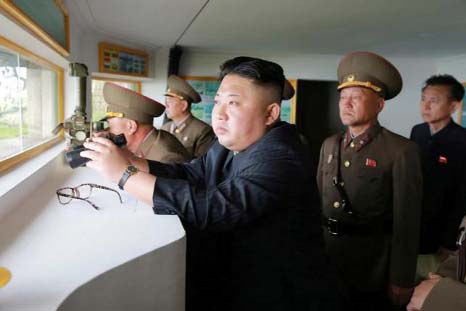
Reuters, Seoul :
North Korea’s successful missile test-launch signals major advances in developing an intercontinental ballistic missile, such as mastery of re-entry technology and better engine performance key to targeting the United States, experts say.
The isolated country has been developing a long-range missile capable of striking the mainland United States mounted with a nuclear warhead. That would require a flight of 8,000 km (4,800 miles) or more and technology to ensure a warhead’s stable re-entry into the atmosphere.
The new strategic ballistic missile named Hwasong-12, fired on Sunday at the highest angle to avoid affecting neighboring countries’ security, flew 787 km (489 miles) on a trajectory reaching an altitude of 2,111.5 km (1,312 miles), the North’s official KCNA said.
The reported details were largely consistent with South Korean and Japanese assessments that it flew further and higher than an intermediate-range missile (IRBM) tested in February from the same region, northwest of Pyongyang.
Such an altitude meant it was launched at a high trajectory, which would limit the lateral distance traveled. But if it was fired at a standard trajectory, it would have a range of at least 4,000 km (2,500 miles), experts said.
The test “represents a level of performance never before seen from a North Korean missile,” John Schilling, an aerospace expert, said in an analysis on the U.S.-based 38 North website.
“It appears to have not only demonstrated an intermediate-range ballistic missile (IRBM) that might enable them to reliably strike the U.S. base at Guam, but more importantly, may represent a substantial advance to developing an intercontinental ballistic missile (ICBM).”
KCNA said the test launch verified the homing feature of the warhead that allowed it to survive “under the worst re-entry situation” and accurately detonate.
The claim, if true, could mark an advancement in the North’s ICBM program exceeding most expectations, said Kim Dong-yub, a professor at Kyungnam University’s Institute of Far Eastern Studies in Seoul.
Kim, a former South Korean navy officer, added the trajectory showed the North was clearly testing the re-entry technology under flight environments consistent for a ICBM.
The North has successfully launched long-range rockets twice to put objects into space. But many had believed it was some years away from mastering re-entry expertise for perfecting an ICBM, which uses similar engineering in early flight stages.
North Korea’s successful missile test-launch signals major advances in developing an intercontinental ballistic missile, such as mastery of re-entry technology and better engine performance key to targeting the United States, experts say.
The isolated country has been developing a long-range missile capable of striking the mainland United States mounted with a nuclear warhead. That would require a flight of 8,000 km (4,800 miles) or more and technology to ensure a warhead’s stable re-entry into the atmosphere.
The new strategic ballistic missile named Hwasong-12, fired on Sunday at the highest angle to avoid affecting neighboring countries’ security, flew 787 km (489 miles) on a trajectory reaching an altitude of 2,111.5 km (1,312 miles), the North’s official KCNA said.
The reported details were largely consistent with South Korean and Japanese assessments that it flew further and higher than an intermediate-range missile (IRBM) tested in February from the same region, northwest of Pyongyang.
Such an altitude meant it was launched at a high trajectory, which would limit the lateral distance traveled. But if it was fired at a standard trajectory, it would have a range of at least 4,000 km (2,500 miles), experts said.
The test “represents a level of performance never before seen from a North Korean missile,” John Schilling, an aerospace expert, said in an analysis on the U.S.-based 38 North website.
“It appears to have not only demonstrated an intermediate-range ballistic missile (IRBM) that might enable them to reliably strike the U.S. base at Guam, but more importantly, may represent a substantial advance to developing an intercontinental ballistic missile (ICBM).”
KCNA said the test launch verified the homing feature of the warhead that allowed it to survive “under the worst re-entry situation” and accurately detonate.
The claim, if true, could mark an advancement in the North’s ICBM program exceeding most expectations, said Kim Dong-yub, a professor at Kyungnam University’s Institute of Far Eastern Studies in Seoul.
Kim, a former South Korean navy officer, added the trajectory showed the North was clearly testing the re-entry technology under flight environments consistent for a ICBM.
The North has successfully launched long-range rockets twice to put objects into space. But many had believed it was some years away from mastering re-entry expertise for perfecting an ICBM, which uses similar engineering in early flight stages.

